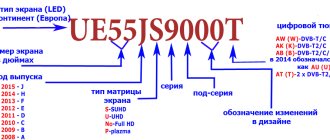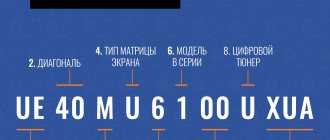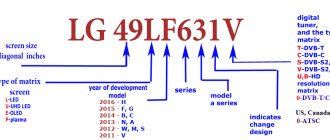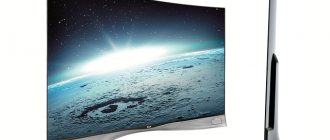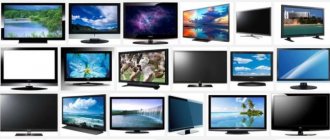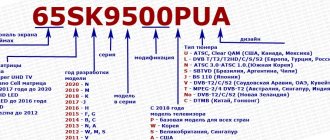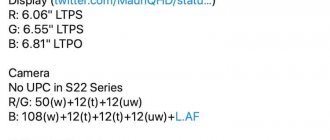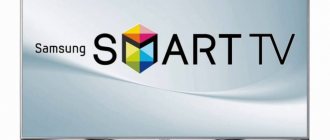Samsung is a large South Korean brand that produces household appliances and electronics. Since 2008, the company has developed a standard that it adheres to to this day when labeling televisions. Equipment from early years of production had different designations, but such devices are practically not found on sale today. What information can a buyer find out from the Samsung TV label: series, model, year of manufacture, display diagonal, tuner, etc. This data looks like a set of letters and numbers. The article will discuss how to decipher them.
Deciphering Samsung TV markings
Marking – alphabetic and numerical designations, drawings and other signs applied to the product necessary to identify the device. They contain information useful to the consumer: properties, features, technical parameters. Even with a little understanding of this issue, you can greatly simplify the choice of a suitable model.
Marking in the form of a sticker is applied to the back of the case, on the packaging box and is duplicated in the technical documentation.
Screen view
The first letter in the model name means the technology used to make the TV display. That is, what kind of backlight does it use:
- C – CRT, picture tube screens (no longer produced);
- K – OLED, organic diodes are used to backlight the screen;
- L – CCFL, matrix illuminated by fluorescent lamps. Models with such a display were in use until 2013;
- P – PDP, “plasma”, produced until 2014;
- U – LED, LCD matrix with LED backlighting, the most popular type.
2021 model with LED screen.
Not long ago, Samsung began to change the shape of the screen, which is also reflected in the markings:
- F – flat;
- C – curved.
From 2021, most models are equipped with a curved display.
Continent
The second letter symbol is the region for which the equipment is produced:
- E – countries of the European Union (Europe);
- A – Australia, Africa, Asia;
- N – Korea, North and South America;
- S – Iran.
For example, if the letters “UE” come first, it means this is an LED-TV released for sale in Europe.
Screen size
In the code, immediately after the first letters there are numbers indicating the size of the display. The screen diagonal is measured not in meters or centimeters, but in inches, where 1 inch = 2.54 cm. For example, if the number is 32, it is multiplied by 2.54, you get 81.28 cm (from one corner of the screen to the other, according to diagonals).
The most popular models are 32 - 65 inches. The dimensions of the TV allow it to be installed in almost any room. Of course, equipment is also available with a larger diagonal, but it is expensive and bulky, so it is only suitable for spacious rooms.
Year of issue
Following the numbers indicating the diagonal are letters again. From them you can find out the year of manufacture of the equipment. The classification has been relevant since 2008:
- A – 2008;
- B – 2009;
- C – 2010;
- D – 2011;
- E – 2012;
- F – 2013;
- H – 2014;
- J – 2015;
- K – 2016;
- Q – 2017;
- N – 2018;
- R – 2019;
- T – 2021.
Marking of the TV 2021 release.
In the marking of some Samsung TVs there is also a second letter:
- H – relevant for older models. Indicates standard case thickness;
- S (SUHD) - the best television receivers made by the company;
- U – devices with Ultra HD (4K) screen resolution.
TV series
Next, 4 digits are indicated in the name. First episode. The model range is represented by series 4 – 9. 9 are the most progressive TVs, expensive, functional, made using innovative technologies. That is, the series below is simpler TV.
The second number marks the subseries. There is no official data on what this means. On the other hand, many technology fans assume that this is a designation of the technical parameters of the device.
The third number is design.
The fourth digit previously, until 2013, indicated the type of tuner. Today it characterizes the appearance of technology.
The series contains important information, for example, the features of the TV, its functionality. Knowing how to read the serial number, it is easier to choose the right model, especially since there are many television receivers on the market that are visually difficult to distinguish one from another. What are the differences between the series:
4 – budget models equipped with a 2-core processor. Resolution is usually 1366 x 768 pixels. Despite the simple characteristics, these TV receivers are great for watching videos, listening to music, games, and applications (if the Smart TV option is available). 4 Series TVs have USB ports to which you can connect external drives. The only thing is that this line does not offer 3D technology and FullHD resolution;- 5 – practically no different from 4, only the screen here has a resolution of 1920 x 1080 pixels. Due to this, the detail of the picture increases, it becomes clearer and cleaner, which is an advantage for film buffs;
- 6 – a universal series, including: a high-quality screen, beautiful design, HDMI connector, improved characteristics. One of the best options in terms of price-quality;
- 7 – light, elegant TVs with thin display frames. This series introduced a built-in camera and the ability to control equipment by voice or gestures. Many models are available with WideColorEnhancerPlus technology, which improves color quality. The AllShare function has also been added - for exchanging data between devices (for example, from a laptop to a TV);
- 8 - roughly speaking, these are VIP-class products, which in terms of functions can replace a desktop computer. In such TVs, in addition to a beautiful design and a branded stand, the frame refresh rate has been increased. 8 Series models have more than 4 HDMI ports and the ability to replace the chipset;
- 9 – new generation devices. Resolution is 3840 x 2160 pixels, which ensures high image clarity. They also put a lot of effort into the design, so these panels fit into any interior.
Tuner
Previously, the digital designation was used:
- 0 – DVB-T. The first types of receivers that receive a digital signal. A classic antenna was used for operation;
- 7 – DVB-T Next generation decoder installations, with a channel providing better throughput.
Today, instead of numbers, the tuner type is indicated by letters:
- AW(W). This is a DVB tuner with DVB-T/C functionality. Decrypts digital broadcasting, but requires a smart card issued by the provider (inserted into a special connector);
- AB (B, AU, U). Also a DVB tuner, with DVB-T2/C/S2 functionality;
- SL. Dual DVB-T/C/S2 decoder;
- AF (BF). Receiver for analog and cable television;
- A.K. Decoder with C, T2 standards;
- AR (DR). Analog TV and digital.
Destination country designation
The last 3 letters indicate in which country the model can be sold. The first one is always X. The second ones are 2:
- BT – Baltic States;
- MS – Asia;
- RU – Russia;
- UA – Ukraine;
- XE – Sweden, Norway, Denmark, Finland;
- XH – Eastern Europe;
- XN – Holland, Belgium, Luxembourg;
- XT – India, Thailand;
- ZG – Germany, Austria, Switzerland;
- ZN – Arab countries.
TV marking RU - Russia.
The USA, England, Italy, Spain and other countries have their own combination of letters.
Conclusion
The rating of the best Samsung 6 series TVs for 2021 has been compiled and it is now clear that the differences between the models are significant. The buyer, of course, always looks towards multifunctionality. Models with a large diagonal must have high frame rates, brightness and contrast. Good TV for Movies, ranked #1, is great in every way. It shows a gorgeous picture, and the interface is convenient and practical. By connecting to the Internet, the user gets access to new films, TV series and favorite programs. Additionally, there are differences in design, so an individual approach is required.
Transcription examples
The markings are always different, as screen technologies, dimensions, years of production, and so on differ. TV panels with a new type of display, which is based on quantum dots, have a different classification.
2020
Example – Samsung UE55TU8072XRU:
- U – light emitting diode (LED) screen;
- E – intended for the European market;
- 55 – diagonal;
- T – 2021 year of manufacture;
- U – DVB-T2/C/S2 receiver;
- 8 – series;
- 072 – characterizes the design, shape of the footrest, color;
- XRU – for sale in the Russian Federation.
2019
QE55Q900RBUXRU:
- Q – QLED screen;
- E – region Europe;
- 55 – diagonal;
- Q900 – series;
- R – 2021 year of manufacture. Starting with this year's models, the screen type is not specified - flat or curved;
- B – generation, in this case the second;
- U – DVB-T2/C/S2 tuner;
- XRU – for sale in the Russian Federation.
Another example is UE43RU7470UXUA:
- U – LED backlight;
- E – Europe;
- 43 – diagonal;
- R – 2021;
- U – UltraHD;
- 7 – series;
- 470 – design, stand, color;
- U – DVB-T2/C/S2 tuner;
- XUA – Ukraine.
2018
This year, the QE55Q7FNAUXRU model turned out to be in demand, where:
- Q –QLED display;
- E – for Europe;
- 55 – diagonal;
- Q – quantum;
- 7 – series;
- F – flat screen;
- N – year of production 2021;
- A – side illumination of the display;
- U – DVB-T2/C/S2 decoder;
- XRU – intended for Russia.
Old models
TV 2021 UE75KS9000AB:
- U – LED backlight;
- E – Europe;
- 75 – diagonal;
- K – 2021;
- S – indicates an ultra-thin body;
- 9 – series;
- 0 – code for sellers and specialists;
- 00 – design, color;
- AB – tuner.
TV 2007 LN-T4671FX/XA:
- LN – LCD screen;
- T – year of production 2007;
- 46 – diagonal;
- 71 – series;
- F – resolution;
- X – design;
- XA – sales region.
Being able to decipher Samsung TV markings is a useful skill. This is not just a set of letters and numbers, but information from which you can glean the characteristics and capabilities of the equipment. Of course, you can evaluate the quality of a TV visually, as it shows. But, knowing dry data, it is easier to compare different models with each other.
Samsung UE60KU6000K
3rd place
LCD TV for the living room Samsung UE60KU6000K took 3rd place on the list. It stands out for its excellent frame rate and huge resolution - 3840 by 2160 pixels. This device does not go beyond the average price category, has excellent backlighting and uses progressive scan technology. Interestingly, the tuner works with the DVB-T2 standard and can be tuned to terrestrial television channels. The speaker power is 20 W, and the multimedia player supports MP3, WMA, MPEG4, MKV, JPEG formats. This “handsome guy” easily makes it into our ranking of the best Samsung 6 series TVs for 2017. Its arsenal includes DLNA and 24 True Cinema functions. As for the interface of the presented device, it is worth noting such ports as AV, HDMI x3, USB x2. The operating system works great, so when setting up channels or effects you don’t have to worry about failures.
HDR is an alternative
TV producers still have a chance to catch up with TV technology: they need to switch to broadcasting in HDR. According to the Ultra HD Forum, 1080p quality with HDR is already considered Ultra HD. To be honest, the improved dynamic range gives the picture even more than the increased resolution. In addition, you will need very little additional bandwidth - from 0% to 25% when compared with SDR (depending on the type of HDR). Switching to high dynamic range could change everything dramatically. How difficult this transition will be for TV companies will depend on the chosen HDR format.
It looks like a turning point has arrived. Time will tell how all this will affect the production of televisions and the television broadcasting business.
Original: The HDTV is officially dead
Specifications of AU8040
Price AU8040 At the time of writing this review: September 2021, the AU8040 series is freely available in Russian stores. The price of the Samsung UE43AU8040UXRU 43″ TV is 50,000 rubles. Samsung UE50AU8040UXRU 50″ TV can be purchased from 55,000 rubles. Samsung UE60AU8040UXRU 55″ costs 63,000 rubles.
Summary of the AU8040 review
In conclusion of the AU8040 review from Samsung, it is worth adding that the TV in question has an excellent price-quality ratio. Its strengths are not much inferior to the TVs presented in the expensive QLED series. It produces excellent images in the dark.
Thanks to its improved reflectance characteristics, it can still produce quite beautiful images in brighter environments. In terms of gaming features, it has low input lag and also comes with a low latency auto mode, which is not always the case in this price range.
Of course, some concessions will have to be made regarding equipment. AU8040 does not have FALD, and has an HDMI 2.1 interface. But if you can do without this, the user gets a decent TV with a good image and not too much of a budget.
Pros Smart features. Excellent image in the dark. Good gaming performance. Decent price. Cons Blurry during fast movements.
No FALD. Not suitable for HDR viewing. Samsung AU8040 - review2021-09-09T18:59:37+03:00 ultrahdSamsungTVsThe Samsung UE55AU8040U 4K HDR TV is a relatively inexpensive and fairly high-quality device from the entry-level line. Of course, you will have to do without some of the premium features that higher-end models have. However, the user will still get really good image quality with a huge number of smart features for relatively little money. Will it be possible...ultrahdultrahd AdministratorUltraHD
